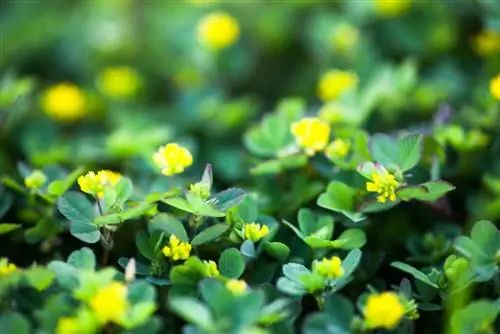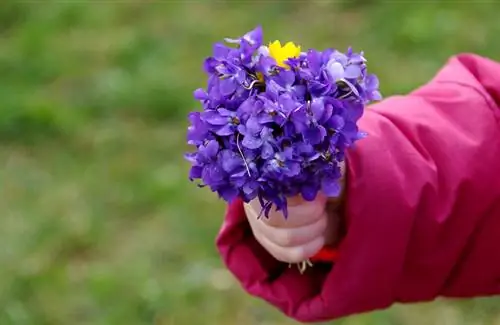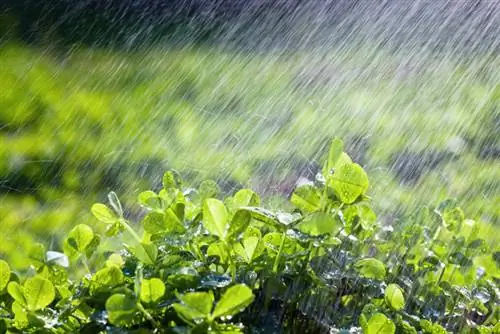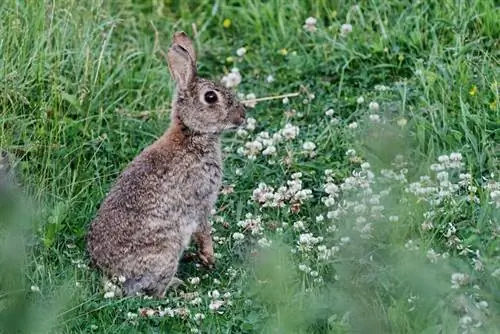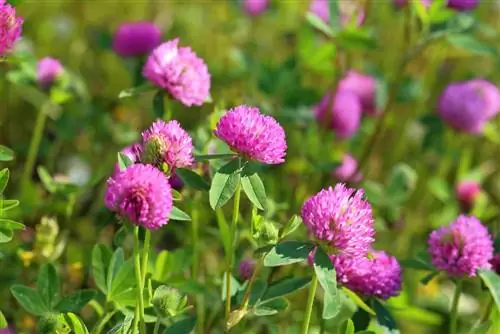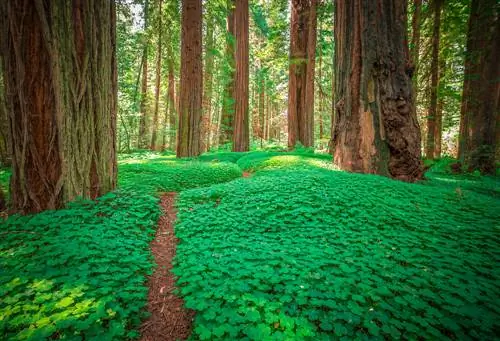- Author admin [email protected].
- Public 2023-12-16 16:46.
- Last modified 2025-01-23 11:22.
Read everything you need to know about growth, flowering time, leaves and use in the commented hop clover profile. Tips on sowing and yellow clover care. You can find out how to combat hop clover here.
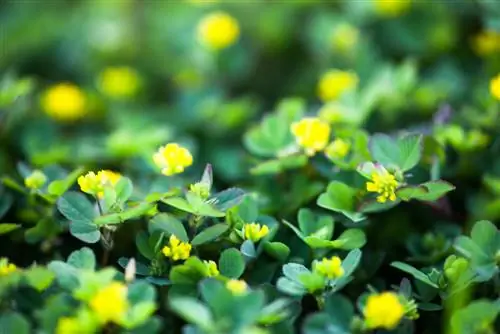
What is hop clover and how can it be used?
Hop clover (Medicago lupulina) is a one- to two-year-old plant from the legume family. Known for its yellow flowers, the hop clover grows 10-50 cm high and prefers sunny to semi-shady locations with calcareous, nutrient-rich soil. It is often used as bee pasture, fodder or green manure.
Profile
- Scientific name: Medicago lupulina
- Family: Legumes (Fabaceae)
- Genus: Snail Clover (Medicago)
- Synonyms: yellow clover, hop alfalfa
- Occurrence: Europe, Asia
- Growth type: biennial perennial
- Growth height: 10 cm to 50 cm
- Leaf: threefold pinnate
- Flower: grape-like
- Fruit: legume
- Winter hardiness: hardy
- Use: fodder plant, pioneer plant, wild vegetable
Growth
Hop clover is an overwintering, one- to two-year-old herbaceous plant that is widespread in Europe. As a green pioneer, yellow clover diligently colonizes wasteland and new building plots. A familiar sight is the local natural treasure along the railway embankments, roadsides and poor meadows. All important key growth data in brief:
- Growth type: herbaceous flowering plant.
- Growth habit: angular stems, prostrate or ascending.
- Growth height: 10 cm to 50 cm
- Roots: spindle-shaped taproot up to 50 cm deep with numerous fibrous roots.
Video: Hop clover viewed up close
Bloom
Hop clover flowers once in the short life of the plant and dies after the seeds ripen. You can easily recognize yellow clover flowers by these characteristics:
- Inflorescence: racemose with 10 to 50 individual flowers
- Single flower: spherical, 5 sepals, 5 petals (2 of which are fused to form a shuttle), 10 stamens
- Flower color: yellow
- Flowering time: May to October
- flower ecology: hermaphrodite
- Pollination: honey bees, wild bees, butterflies
The literal translation of the botanical name Medicago lupulina is: snail clover hop-like. In fact, the inflorescences are vaguely reminiscent of the yellow, cone-shaped hop flowers (Humulus lupulus). This is where the common names hop clover and hop alfalfa come from.
Leaf
These characteristics characterize a hop clover leaf:
- Leaf shape: threefold pinnate (middle leaflet stalked, side leaflets sessile).
- Single leaflet: obovate, serrated leaf edge at the front.
- Special identifying feature: Leaflets with attached tip.
- Leaf properties: evergreen, edible.
Fruit
At the end of the flowering period, the racemose inflorescences transform into tiny legumes with a distinctive shape and other interesting properties:
- Fruit shape: kidney-shaped, rolled like a snail (hence the genus name snail clover).
- Fruit color: brown-black
- Distribution strategy: Rainwash
Falling raindrops cause the walls of the legumes to burst open and wash out the seeds. Other yellow-flowering natural beauties also use this propagation method, such as marsh marigolds (C altha palustris) and winter aconites (Eranthis hyemalis).
Usage
Natural hobby gardeners appreciate the benefits of hop clover for its many different uses. The following table gives an overview of how yellow clover can be useful in your garden:
| Natural Garden | Cuttable Garden | Apothecary Garden |
|---|---|---|
| Bee Pasture | Forage plant | Medicinal plant |
| Pioneer Plant | Wild vegetables | Healing effects: |
| Lawn replacement | Green manure | + diuretic |
| Groundcover | Underseeding | + antispasmodic |
Hop clover has made a name for itself in undersown mixtures as a mixture partner for white clover. An important mixing partner is yellow clover in clover grass cultivation for difficult, emaciated, dry locations where meadow clover fails.
Planting hop clover
The best planting method for hop clover in the home garden is sowing in the bed. Yellow clover seeds are light germinators and do not require any pretreatment. Read useful planting tips:
Location
Basically, hop clover grows wherever you spread the seeds. Yellow clover proves its optimum as a natural treasure under these conditions:
- Sunny to partially shaded location.
- Summer warm and protected from late frosts.
- Normal garden soil, preferably dry to fresh, calcareous, nutrient-rich, alkaline pH value greater than 8.
- Exclusion criteria: waterlogging, acidic pH value.
Sowing
The window for sowing opens at the beginning of April. This date guarantees robust winter hardiness. Hop clover that is sown too early, on the other hand, is sensitive to frost. The sowing season extends into August. The following short instructions explain how to sow yellow clover seeds correctly:
- Prepare the seedbed: weed, rake in sifted compost, rake until finely crumbly.
- Fill seeds into a spreader (€23.00 on Amazon), set the distribution quantity to 2.0 g to 2.5 g per m².
- Walk the area lengthwise and crosswise with the spreader.
- Work seeds in with a rake or rake to a depth of 0.5 cm to 1 cm.
- Rolling the seedbed.
The easiest way to water the hop clover area is with a lawn sprinkler or garden hose set to a fine spray.
Excursus
Explosive pollination
Hop clover welcomes its pollinators with an explosive welcome. As soon as the first honey bee lands on a flower, the stamens shoot out of the shuttle, press against the insect's abdomen and transfer the pollen. With the pollen in their luggage, the insects pollinate the next yellow clover flower. Other species of snail clover use this silent explosion mechanism, such as Medicago falcata, a yellow-flowering subspecies of sickle clover (Medicago sativa).
Care for hop clover
In the hobby garden, hop clover meets with a mixed response. Critics consider yellow clover a weed. Advocates warmly welcome the yellow-flowering clover. In the following sections, both factions read practical tips on fighting without poison and on low-maintenance care.
Fighting hop clover
Yellow clover can be very annoying in the lawn. If moss cannot be seen due to a high pH value, the prostrate stems will brazenly spread across the green area. Read the best tips here on how to successfully combat hop clover without using poison:
- Remove yellow clover nests by hand with a weed cutter.
- Here's how it works: Moisten the lawn, stick a V-shaped shovel blade into the ground, lift the yellow clover out of the ground using the roots.
- If there is a large area of clover infestation, scarify the lawn in April and September.
- Here's how it works: mow the lawn briefly, scarify it in a checkerboard pattern, sweep away any weeds that have been combed out, mow again, fertilize after 2 weeks.
- Extra tip: Do not lime the lawn with hop clover.
The best prevention against renewed hop clover infestation is regular mowing that is not too deep. All one- to two-year-old clover species spread primarily through self-seeding. By not allowing yellow clover to bloom, the lawn weeds will retreat. You can do this by cutting the lawn every 5 to 7 days from spring until the first frost. Do not mow the green area deeper than 4 centimeters. With this stalk height, lawn grasses overshadow the seedlings of hop clover and thus prevent photosynthesis.
Care tips
In the natural garden, hop clover is a welcome guest with modest requirements. You can simply leave the native species of snail clover to its own devices. Yellow clover thanks you for a little gardening attention with dense, flower-rich growth from spring to autumn. The best care tips to read:
- Watering: Water hop clover sparingly (moderately dry soil promotes competitiveness).
- Fertilizing: fertilize in March/April and June/July with compost, horn shavings or nettle manure.
- Lime: if the pH value is less than 7.5, lime the soil with garden lime or algae lime.
Special case: hop clover as green manure
As a green manure, hop clover promotes soil fertility in ornamental gardens and vegetable beds. Its roots serve as a habitat for nodule bacteria. In return, the bacteria transform atmospheric nitrogen into plant-available nitrogen, an important main nutrient and engine of growth. Plowing under yellow clover roots also provides the surrounding garden soil with the vital nutrient.
Sown as a single seed or mixed partner for green manure, mow hop clover after the flowering period. The roots with the nodule bacteria remain in the soil as a soil activator. The clippings are disposed of on the compost heap or remain lying, wilt and are raked up.
Popular varieties
The natural beauty of yellow clover cannot be improved through breeding interventions. For this reason, no hop clover varieties can be found in stores.
FAQ
Is hop clover edible?
Yes, some parts of hop clover are edible. However, consumption does not promise culinary delights due to the bitter taste. From May to July, collect the tender leaves and young sprouts to prepare as wild vegetables, salad or herb quark. During the flowering period between May and October, the flowers are suitable as an edible decoration for savory dishes.
How to destroy hop clover in the lawn?
There are various options for destroying hop clover in the lawn. You can effectively combat annoying clover with a scarifier. As you walk the green area with the device, rotating blades comb out moss, yellow clover and other lawn weeds. You can radically and effectively destroy hop clover if you cover the lawn with dark foil for six to eight weeks. This control is always considered when there are more weeds growing in the lawn than noble grasses. You can't avoid reseeding the lawn afterwards.
What healing properties does hop clover have?
Natural medicine certifies that hop clover has a laxative, diuretic and calming effect. As a tea preparation made from dried leaves and flowers, yellow clover relieves symptoms such as flatulence, stomach pressure and loss of appetite. If you are plagued by everyday stress, simply enjoy a good cup of soothing hop clover tea.
Is hop clover suitable for bee-friendly gardens?
Hop clover is a valuable source of pollen and nectar with a remarkable insect value of 4. The native species of snail clover forms numerous yellow spherical flowers with prostrate stems and is reasonably sturdy. You can therefore easily integrate yellow clover into your bee-friendly garden as a single seed or wildflower mix. The Ministry of Food and Agriculture recommends hop clover as a bee-friendly plant for private and commercial cultivation alike.
When is the best time to sow hop clover?
In contrast to meadow clover and other native types of clover, hop clover seedlings are sensitive to frost. For this reason, the best time for sowing is between early April and mid-May. In harsh winter locations, you should wait for the ice saints before sowing yellow clover seeds.

